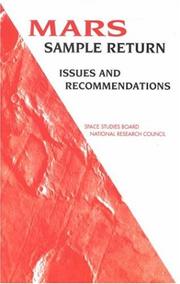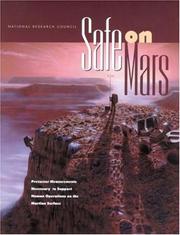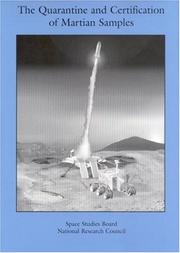| Listing 1 - 6 of 6 |
Sort by
|
Book
ISBN: 3443642489 Year: 2000 Publisher: Berlin J. Cramer
Abstract | Keywords | Export | Availability | Bookmark
 Loading...
Loading...Choose an application
- Reference Manager
- EndNote
- RefWorks (Direct export to RefWorks)
Central Europe --- historical ecology --- palynology --- pollen surface samples

ISBN: 0309057337 0309524474 0585001766 9780585001760 9780309057332 0305057337 0309174872 9780309174879 9780309524476 Year: 1997 Publisher: Washington, D.C. National Academy Press
Abstract | Keywords | Export | Availability | Bookmark
 Loading...
Loading...Choose an application
- Reference Manager
- EndNote
- RefWorks (Direct export to RefWorks)
Mars surface samples. --- Space vehicles -- Contamination. --- Mars surface samples --- Space vehicles --- Astronomy & Astrophysics --- Physical Sciences & Mathematics --- Astrophysics --- Contamination --- Contamination. --- Mars samples --- Contamination (Technology)

ISBN: 0309084261 9786610183784 1280183780 0309502004 9780309502009 030908654X 9780309086547 9780309084260 0305084261 0309169593 Year: 2002 Publisher: Washington, D.C. : National Academy Press,
Abstract | Keywords | Export | Availability | Bookmark
 Loading...
Loading...Choose an application
- Reference Manager
- EndNote
- RefWorks (Direct export to RefWorks)
Electronic books. -- local. --- Mars (Planet) -- Equipment and supplies. --- Mars (Planet) -- Exploration. --- Mars surface samples -- Contamination. --- Mars surface samples. --- Planetary quarantine. --- Mars surface samples --- Planetary quarantine --- Astrophysics --- Astronomy & Astrophysics --- Physical Sciences & Mathematics --- Contamination --- Contamination. --- Mars (Planet) --- Exploration. --- Equipment and supplies. --- Mars samples --- Red Planet --- Quarantine --- Space biology --- Space vehicles --- World health --- Sterilization

ISBN: 0309075718 9780309511518 0309511518 9780309511513 9780309075718 0305075718 0309170753 Year: 2002 Publisher: Washington, D.C. National Academy Press
Abstract | Keywords | Export | Availability | Bookmark
 Loading...
Loading...Choose an application
- Reference Manager
- EndNote
- RefWorks (Direct export to RefWorks)
Mars (Planet) -- Exploration -- Equipment and supplies. --- Mars surface samples -- Contamination. --- Mars surface samples. --- Planetary quarantine. --- Space vehicles -- Contamination. --- Mars surface samples --- Planetary quarantine --- Space vehicles --- Astrophysics --- Astronomy & Astrophysics --- Physical Sciences & Mathematics --- Contamination --- Contamination. --- Mars (Planet) --- Exploration --- Equipment and supplies. --- Mars samples --- Equipment --- Contamination (Technology) --- Quarantine --- Space biology --- World health --- Sterilization
Book
ISBN: 128213034X 9786612130342 0309130743 9780309130745 0309130735 9780309130738 030917760X Year: 2009 Publisher: Washington, D.C. : National Academies Press,
Abstract | Keywords | Export | Availability | Bookmark
 Loading...
Loading...Choose an application
- Reference Manager
- EndNote
- RefWorks (Direct export to RefWorks)
NASA maintains a planetary protection policy to avoid the forward biological contamination of other worlds by terrestrial organisms, and back biological contamination of Earth from the return of extraterrestrial materials by spaceflight missions. Forward-contamination issues related to Mars missions were addressed in a 2006 National Research Council (NRC) book, Preventing the Forward Contamination of Mars. However, it has been more than 10 years since back-contamination issues were last examined. Driven by a renewed interest in Mars sample return missions, this book reviews, updates, and replaces the planetary protection conclusions and recommendations contained in the NRC's 1997 report Mars Sample Return: Issues and Recommendations. The specific issues addressed in this book include the following: the potential for living entities to be included in samples returned from Mars; scientific investigations that should be conducted to reduce uncertainty in the above assessment; the potential for large-scale effects on Earth's environment by any returned entity released to the environment; criteria for intentional sample release, taking note of current and anticipated regulatory frameworks; and the status of technological measures that could be taken on a mission to prevent the inadvertent release of a returned sample into Earth's biosphere.
Space flight to Mars --- Space microbiology. --- Mars surface samples. --- Microbial contamination --- Contamination, Microbial --- Contamination by microorganisms --- Microbiological contamination --- Contamination (Technology) --- Biological decontamination --- Sanitary microbiology --- Mars samples --- Aerospace microbiology --- Microbiology --- Space biology --- Interplanetary voyages --- Planning. --- Prevention. --- Mars (Planet) --- Exploration.
Book
ISBN: 3036558411 303655842X Year: 2022 Publisher: Basel MDPI - Multidisciplinary Digital Publishing Institute
Abstract | Keywords | Export | Availability | Bookmark
 Loading...
Loading...Choose an application
- Reference Manager
- EndNote
- RefWorks (Direct export to RefWorks)
This is a reprint of the MDPI IJERPH Special Issue entitled "COVID-19 and Environment: Impacts of a Global Pandemic". The reprint consists of 17 papers with different topics related to the COVID-19 pandemic and environmental impacts using data from different countries all over the globe.
Medicine --- Epidemiology & medical statistics --- risk perception --- China as an international tourism destination --- anticipated emotions --- destination attachment --- post-pandemic --- COVID-19 --- customer behavior --- psychological process --- live-streaming shopping apps --- stimulus-organism-response framework --- Unified Theory of Acceptance and Use of Technology 2 --- Flow Theory --- gender --- age --- SARS-CoV-2 --- environmental contamination --- air samples --- surface samples --- bottom trawling --- COVID-19 pandemic lockdown --- environmental impacts --- macrobenthic fauna --- tidal channels --- central Mediterranean Sea --- ethnopharmacology --- skin diseases --- cosmetics --- Lithuania --- global environment --- solid waste --- air quality --- transport --- airborne --- CO2 --- collective transport --- tramway --- filtration --- infectious diseases --- epidemiology --- public health --- elementary teacher --- junior high school teacher --- psychological change --- physical changes --- urban mobility --- parking demand --- IoT parking sensors --- explanatory data analysis --- parking policies --- vaccinations --- pharmacist --- KAP --- infection control --- burnout --- COVID-19 pandemic --- postnatal care --- psychological distress --- psychosocial support --- health-seeking behavior --- appendicitis --- surgical care --- metrology --- data analysis --- atmospheric environment --- pollution --- coronavirus --- comorbidity --- spatial analysis --- logistic regression --- ROC curve --- freight transport --- air freight --- sea shipping --- road transport --- recovery measures --- strategies --- public trust --- perceived societal fairness --- mental health --- air pollution --- PM2.5 concentration --- gym sports --- spatial econometric model
| Listing 1 - 6 of 6 |
Sort by
|

 Search
Search Feedback
Feedback About UniCat
About UniCat  Help
Help News
News